|
|
|
 |
|
| back |
|
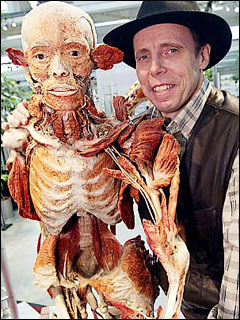
GUNTHER VON HAGENS INTERVIEW (BODY WORLDS)
By Ron Sawyer
Gunther von Hagens is a German anatomist who created an intriguing body preserving process known as plastination. His anatomy exhibit titled Body Worlds and the new Body Worlds 2 have been touring around the world and are currently touring the USA. We recently met up with him at his exhibit in Los Angeles and had a chance to discuss his fascinating exhibit.
I saw the Body Worlds exhibit a few years ago when it was in England and at the time I had assumed that in America this sort of exhibit would have been boycotted, especially with the recent uproar here over nudity on TV. It seems that in the USA censorship runs rampant. Did you have any problems arranging the exhibit in the USA because of that?
|
|
|
|

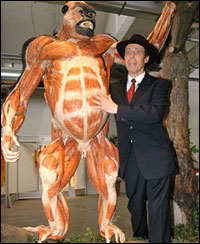
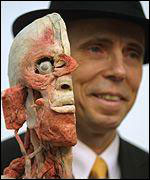
|
|
No, not at all. Of course by purpose, I was happy to agree to the invitation of the California Science Center and I think one thing America understands is that education stands apart of puritanic considerations. When I am able - and I was able and the California Science Center, we were able together - to bring across a message that this is a scientific exhibition I think that the misconception had already been dissolved that this is not a freakshow and therefore to medicine, to enlightenment belongs and nudity that I show here is certainly the 'nude of the nudity', it's the nudity beneath the skin but it's a necessary sight of anatomy which actually is all the organ systems including the reproductive system and in the times of A.I.D.S. I think where the rate in America is higher than ever that a proper teaching, education in all body functions, including the sexual function in a scientific way is necessary.
Your exhibits cause controversy because some people feel that the artistic way in which you display some of the bodies is exploitive and they feel that you're playing up the shock value. What would your response be to people who feel this way?
Go to the exhibition and watch the reaction of the visitors and you will see that the shock they get is just an aesthetic shock, a health shock, a shock of suddenly being enriched about much more knowledge, about how important it is to live a healthy lifestyle, to achieve a more healthy, capable and longer life. Most of the critics don't come to the exhibit. I think it's much more dignifying not to take the body apart but to show the body as intact as possible when you are able to teach at the same time. It's especially important for the laypeople. Therefore, I'm in the tradition of the anatomists of the renaissance which, for good reason, invented this principle of presenting the human body in a lifelike way, closing in this way the gap between the living and the dead and I feel myself in the tradition of those renaissance artists of anatomy, artists in a way of high craftsmanship to be defined as the aesthetic didactic presentation of the body interior. I believe that the development of this kind of whole body display like I did by additionally opening body doors, by expanding the specimens in all directions to make visible the inside without taking parts away. By the very important concept that I compare healthy entity organs in showcases it is much more dignifying for those who donated their bodies. Another reason which I tell the critics, we should not talk about some dignity of mankind as our ethical judgments are culture-dependent and as long as large populations like this exibition, and independent surveys show that, especially for a democratic society, it's essential that we honor the will, not only of the living who want to see this but also of the dead, to honor their testimony. It is a very humane obligation that we should respect the last will. These people are plastinated and they know exactly what will happen to them because actually, most of them decided to become body donors after being at the exhibition. Although, I don't think that by this kind of wording we should degrade the value of art. And therefore everybody can - or many people put into this exhibition their notion of art but we should not forget that actually aesthetic display and vivid display of life, like emotional display means a display of art. When a woman puts herself in a nice pose, puts some lipstick on and a necklace on, she doesn't become a piece of art just because she is more beautiful. Like my visitors are more interested in the specimens, that makes the specimens more visible. And I think when we want to teach them, when we want to change the way that people think about their own body in a health educating way we must do it in an emotional way and therefore, what I create here I call it 'emotional anatomy', I call it 'event anatomy'. A good teacher, especially in anatomy, in the visual sides should also be a good showmaster.
|
|
|
At the London exhibit, you had a publicly televised human autopsy. A few doctors who were present at the autopsy said that this is something the public shouldn't be allowed to experience but is something that should be exclusively for the scientific community. How has the reaction been from doctors and scientists in general? Has it been positive?
Very much more positive in Europe, I think comparably like in Asian, Switzerland and in Austria it was very well received. I knew always - and it was proven here - that the American medical experts are paying a higher tribute and a high importance to the education of the laypeople, of the public, whereas in Germany, it is perhaps under my level and regarded a bit like 'sowing pearls in front of the pigs'. The laypeople are here as taxpayers and as objects of anatomy, they are much more esteemed here. It is the right of the individual, everybody to have the same access to knowledge is fully recognized in the US. Nowhere do you have better books for laypeople in chemistry, medicine and anatomy than in America. This always fascinated me, the educational approach of the American educational system. This was also true for Body Worlds here. I did not have any of those, let's say untimely and backward comments like I heard in Germany from colleagues of mine who said that they should not be shown for laypeople, that they should learn from models because it's too complex. Because here patients are seen really as partners. And therefore, the patient must, as much as possible, know what happens. And this is one reason the exhibition is so successful here without any controversy because the medical profession is behind it.
So it's more well-received in the USA than in Europe?
Well, I would say Europe is not Europe. Better than in Germany and England. But I would say it was fully applauded and recognized in Switzerland, in Austria and especially in Japan and Korea and in Taiwan, where the Mayor came, the House Minister, the Education Minister came. So I have the support of laypeople and the scientists. And I also want to say that I found that the Americans are a very curious nation, very body-conscious and they value health education very highly, much higher than many other countries.
|
|
I was fascinated to see the human autopsy on television in England. Do you plan to do more autopsies for the public to experience?
I think it's certainly something different to see a ready exhibition or see how the specimens are developed, how the bodies are opened. And although it's certainly a special route to knowledge and I think it's very valuable for the laypeople and the reaction of the laypeople in London showed it to me and I think this is a very useful way to educate but I haven't been in America long enough, to tell you the truth, to know whether this is the right time in history, that this would be taken in the right way as a democratization of anatomy in order to help medical science and to explain and to show actually how important that medical procedure is. So I'm still in the process of evaluating whether and when the time is suitable to do that event in the United States.
|
|
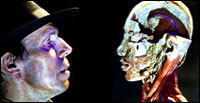
|
|
|
Can you tell us a bit about Plastination City?
Yes. 400 people, worldwide, work under my scientific leadership: 200 in China, 35 in Kyrgyzstan and I've now opened another plastination facility in Poland. So I focus my work very much on my Chinese staff because they have such a high command of fine muscle position dexterity so we do the silicone specimens over there and improve the blood vessel configuration technology, whereas in Europe I'm developing the high tech plastination methods like sheet plastination.
Have you made any medical breakthroughs through your anatomy research?
The sheet plastination method is used as a diagnostic tool in pathology. Post amputates are labeled, cut in slices and plastinated and the organ can be fully screened, like amputated breasts for cancer. It's very tedious and costs too much money slice by slice. It's 7 micron sections but doing it as sheet plastination it's proper though. In this way I enriched the medical technology with a new diagnostic tool possibility, whereas the silicone specimens prove to be more useful as a teaching tool.
|
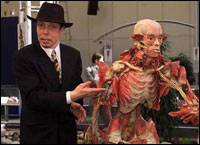
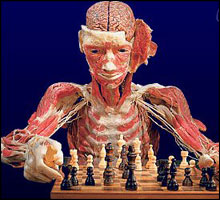
|
|
Have you come across any problems when someone donates their body but their family doesn't want the body plastinated?
It doesn't actually happen because we strongly suggest that if there is not full agreement in the family that the people go to a notary. There are some specimens we never get. But we have never had any problems. So what happens occasionally in anatomy is that someone who is a family member wants the body back. It has never happened.
Attitudes about death differ greatly between eastern and western societies. In the west, people try to minimize their exposure to the body. They take it to the morgue and the body is prepared and you hardly ever see the body. Maybe a brief viewing of the body at the grave. Whereas in eastern societies like in Buddhism and Zen religions they tend to have the body in public view and more time is spend in the presence of the body. Would you consider eastern societies or western societies to be more advanced in their thinking?
I think there is not the possibility that either is better. It's culturally inherited. And whether it's better to give the dead bodies to the birds, like in Tibet or putting them into the jungle like some African tribes do or burn them or put them into the earth. I think this cannot be judged as good or bad. I think what is important is that the whole society is behind it. And I would not go with a division of east and west because the east is very much divided and the west is very much divided. Look how differently the funeral rites are in America, for example, compared to Germany. Here, you embalm everybody and usually you display it and in Germany you don't display it and you never embalm it. It is prohibited by law. The Buddhists have no problem seeing the rotting corpses whereas the Christians do. But the Christians are more easy with the body donation because from a religious point of view, Christianity of the dualism of soul and in the Bible with resurrection a new body will be given to you. In this way Christianity is, in my opinion, the most anatomy-friendly religion on Earth. For that reason, actually, anatomy before modern time was born in Italy in the 16th century. The anatomy artists at that time were supported by the popes and for a long time anatomy was even a religious subject. Autopsies were done in the churches in Germany, like in Regensburg. Popes were dissected with the aim, "Lord, how wonderful you have done us." And the second importance was medical value. And in this way, I continue with this kind of lifelike whole body oriented anatomy.
|
|
|
You've mentioned in your biography that you are planning to have your own body plastinated. Do you plan to have any connection with yourself so people realize it's you, like perhaps have your hat on it or do you want to remain anonymous?
I'm not vain. Of course after my death this should be decided by my wife. She is younger and she will live longer. Or my son. And whether then I will be cut in slices or whether I will be dissected in a lifelike position, like my son suggested, it will be decided by the next generation. I will not load them with some kind of requests which then are difficult to realize because usually, after somebody dies there are anyhow already enough opinions what they will do in detail.
|
|
At what point in your life did you first gain an interest in anatomy?
I would say it was exactly at the age if six, when I had a head injury and I was rushed to the operating theater with constant bleeding. And when I went to anesthesia, which was ether at this time, I heard the physicians discussing that probably I would not make it, I would die. So I thought what would happen. Is it bad for me? Would my parents be very sorry because they just bought me some pears? And then, when I woke up I thought, "Oh, I'm living. How interesting." The doctor came and listened to me with a stethoscope and I thought, "Oh, I'm really interesting to him. I'm some kind of treasure to those big people with white coats and they look at all of my body." So I decided at this time that I wanted to become one of those doctors because I wanted to look in the body. I wanted to become a medical doctor.
You say that back then they were using ether still? Did they spray it?
Yeah, it was with a mask.
Can you tell us about your future plans for the exhibit. Is it true that you might be opening a permanent museum somewhere.
Yes. Now that I have learned the reaction of the American people perhaps I'll put a permanent museum here. But I think I must show the exhibition for about one year, talk to the people daily, talk with journalists like you, get a feeling for America. I'll only spent a total of about one year here. It's not enough. Therefore, I accepted a visiting professorship at New York University where I'll start to teach in school next January. So this is my long term goal, bringing democratization of anatomy to such a stage that people are really interested to know that there is always a permanent Body World museum which is in quality and size unsurpassed and is bigger and more detailed than this one here
|
|
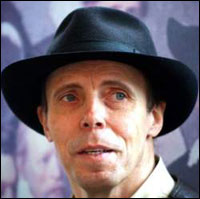

|
|
|
One last question. This interview is for a music magazine so I should probably ask what types of music you listen to.
I listen to classic music but I play more music than I listen. I play the violin every day, even this morning. I have it always with me. I have an electric violin for traveling. It's always in my suitcase. In the hotel room I can play in the night always and I play on average an hour a day. I played as a youngster between 9 and 14 and then I had no time. I didn't have a very good teacher, I would say, and I lost interest but I always loved it. I loved music so much. I love the violin concerts especially Max Bruch. Two years ago when I became more successful I started again and now I do it every day. It gives me a kind of relaxation. It is a kind of hobby. It's a very 'uncomplicated girlfriend' I have. But I have headaches. I play only a half hour. I'm in tune with the world again. It gives me good emotions. I'm very grateful to my parents because I started as a young child. Otherwise I wouldn't have the basics. In this age, it's too difficult to start at my age now. I'm making good progress. I'm very happy. Other than that, I also like dance music but more in a classical way. I did ballroom dancing between the age of 14 and 19, professional ballroom dancing. In this way I got a very good feeling for posing, postures, you know, how important eye movement is, the position of the body. So I was trained by myself and it attributed to my skill now to pose the specimens properly.
|
|
It definitely shows in your work too. Do you have any final comments you'd like to say?
I'd like to add that I came to America rather late, after 15 million people had seen it, after my exhibition was so developed that I know that I will enrich the American educational system through plastination. I'm a friend of America. As an East German, America was always a dream. As a former political prisoner, America was something like the haven of democracy. And I think I'm here as a messenger, as a German who actually experienced communism and can make the American people understand that it is worthwhile to stick to their democratic conviction and that actually winning the Cold War the way they did I think showed the whole world that finally, democracy will endure. So I am very happy to be in this country and I want to learn a lot from this society which is a very diverse society with many different ethnic groups. You are quite a nation here. Yeah, in this way I see the democratization of anatomy which I bring here to America as a small token to enrich this American dream. Public museums are always very successful here. There were public autopsies in America, there is the Mutter museum in Philadelphia and the IAP, International Academy of Pathology Museum in Washington DC. There is a very interesting history of museums. So I think that the American public is especially ready for Body Worlds because it's a secularized society, especially the young people. They are body-oriented. They are not concerned anymore with whether their soul goes to heaven or hell but whether they will keep and enjoy a healthy body which will not suffer before they die and they will have a long life. And in this way I feel a vacuum which is actually not addressed by the church because they only care for the soul. All the other body activities like exercise, aerobics, or whatever really brings us to ourselves. It shows our inner face, how individual we are, down to the genes. The message which I want to bring over is that we are an anatomical treasure that will build body pride in the people. It comes to America at the right time. So I believe that when I'm plastinated myself it will be normal in schools that plastinates are around and someday the people will wonder what there was before this guy came to America, that there were really plastic models for teaching about a human body.
www.bodyworlds.com
Current exhibit:
October 7, 2005 - April 23, 2006 PHILADELPHIA
Courtesy of Ron Sawyer
Editor, Livid Looking Glass Magazine
|
|
|
|
|
|
|
|
| back |
|
|